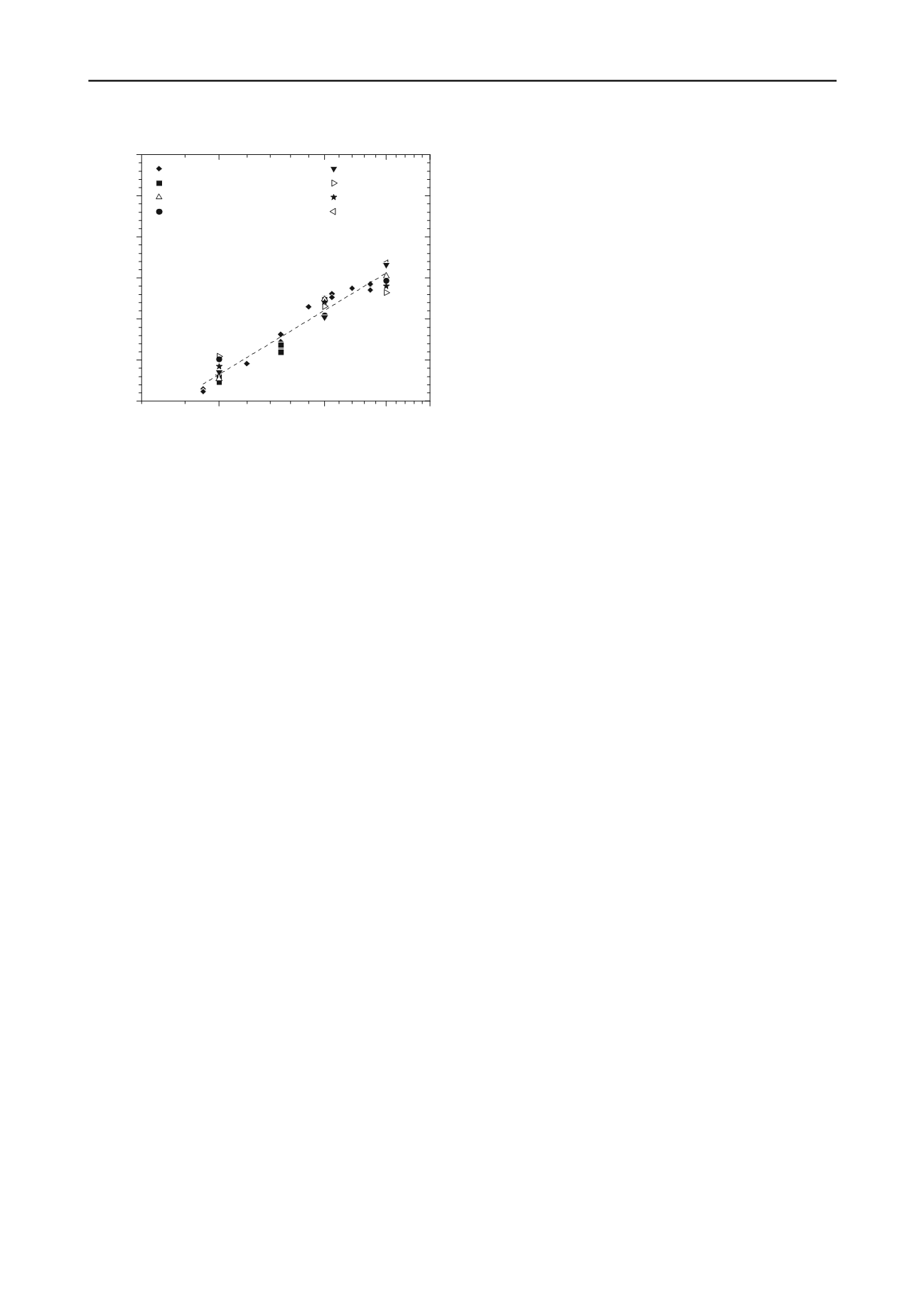
2460
Proceedings of the 18
th
International Conference on Soil Mechanics and Geotechnical Engineering, Paris 2013
Proceedings of the 18
th
International Conference on Soil Mechanics and Geotechnical Engineering, Paris 2013
Figure 4. Generalized strength equation for the unconfined compressive
strength of cement based stabilized soft soils.
5 CONCLUSION
The paper presents a new simple method to predict the
unconfined compressive strength at 28 days of curing time of
cement based stabilized soft soils, whatever be the water content
and binder content. The method was initially developed for the
soft soil of “Baixo Mondego” chemically stabilized, and then
was sucessfully applied to a wide range of cement based
stabilized soft soils. Thus, this new method seems to be
independent of the soft soil, which allows the definition of a
generalize relationship (presented in Figure 4). At limit, the
number of unconfined compression tests required can be
reduced to one if it is applied the generalized equation and the
binder content chosen is 18%. The method proposed in this
paper is helpful for the laboratory optimization process of the
chemical stabilization at the pre-design stage.
6 ACKNOWLEDGEMENTS
The authors would like to express their thanks to CIMPOR for
supplying the binders used in the work and to the institutions
that supported the research financially: University of Coimbra,
CIEC and FCT (PTDC/ECM/101875/2008).
7 REFERENCES
Åhnberg H. 2006. Strength of stabilised soils – a laboratory study on
clays and organic soils stabilised with different types of binder.
PhD Thesis, University of Lund, Sweden.
Coelho P.A.L.F. 2000.
Geotechnical characterization of soft soils. Study
of the experimental site of Quinta do Foja
, MSc Dissertation,
University of Coimbra (in portuguese).
Correia A.A.S. 2011.
Applicability of deep mixing technique to the soft
soils of Baixo Mondego
, Ph.D. Dissertation, University of Coimbra,
Portugal (in Portuguese).
Edil T.B. and Staab D.A. 2005.
Practitioner’s guide for deep-mixed
stabilization of organic soils and peat. Final Report.
The National
Deep Mixing Research Program, Project Number NDM302, p. 60.
EN 197-1 2000.
Cement - Part 1: Composition, specifications and
conformity criteria for common cements
. IPQ, Portuguese edition
from April of 2001, 35 p.
EN 14679 2005.
Execution of special geotechnical works – deep mixing
.
CEN, English version, April of 2005, p. 52.
Eurosoilstab 2001.
Development of design and construction methods to
stabilise soft organic soils. Design guide soft soil stabilization
.
CT97-0351, EC Project No. BE 96-3177, Industrial & Materials
Technologies
Programme
(BriteEuRam
III),
European
Commission, p. 94.
10
20
30
40
0,0
0,5
1,0
1,5
2,0
2,5
3,0
Kangawa clay
Aichi clay
Osaka clay
Hiroshima clay
Baixo Mondego clayey-silt
Ariake clay
Tokyo clay
Chiba clay
q
IL
/[q
IL=1 (a
w
=18%)
] = -2.26 + 1.12.ln(a
w
)
(R
2
= 0.94)
q
IL
/ [q
IL=1
(
a
W
= 18%
)]
a
w
(%)
Hernandez-Martinez F.G. 2006.
Ground improvement of organic soils
using wet deep soil mixing
. PhD Thesis, University of Cambridge,
United Kingdom.
Horpibulsuk S. 2001.
Analysis and assessment of engineering behavior
of cement stabilized clays.
PhD Dissertation, Saga University, Saga,
Japan.
Horpibulsuk S., Runglawan R. and Suddeepong A. 2011. Assessment of
strength development in blended cement admixed Bangkok clay.
Construction and Building Materials
, Vol. 25, No. 4, p. 1521-1531.
Horpibulsuk S., Miura N. and Bergado D.T. 2004. Undrained shear
behavior of cement admixed clay at high water content.
Journal of
Geotechnical and Geoenvironmental Engineering
, ASCE, Vol. 130,
No. 10, p. 1096–1105.
Horpibulsuk S., Miura N. and Nagaraj T.S. 2003. Assessment of
strength development in cement-admixed high water content clays
with Abrams' law as a basis.
Géotechnique
, Vol. 53, No. 4, p. 439 –
444.
Kamruzzaman A.H.M. 2002.
Physico-chemical and engineering
behavior of cement treated Singapore marine clay
. PhD Thesis,
Department of Civil Engineering, National University of Singapore.
Kawasaki T., Niina A., Saitoh S. and Honjyo Y. 1981. Deep mixing
method using cement hardening agent.
Proceedings of the 10th
International Conference on Soil Mechanics and Foundation
Engineering
, Vol 3, p. 721-724.
Kitazume M. and Terashi M. 2002.
The deep mixing method – principle,
design and construction
. Edited by Coastal Development Institute
of Technology, Japan. Balkema.
Locat J., Trembley H. and Leroueil S. 1996. Mechanical and hydraulic
behaviour of a soft inorganic clay treated with lime.
Canadian
Geotechnical Journal
, Vol. 33, p. 654 – 669.
Lorenzo G.A., and Bergado D.T. 2004. Fundamental parameters of
cement-admixed clay- New approach.
Journal of Geotechnical and
Geoenvironmental Engineering
, ASCE, Vol. 130, No. 10, p. 1042-
1050.
Lorenzo G.A., and Bergado D.T. 2006. Fundamental characteristics of
cement-admixed clay in deep mixing.
Journal of Materials in Civil
Engineering
, ASCE, Vol. 18, No. 2, p. 161-174.
Miura N., Horpibulsuk S. and Nagaraj T.S. 2001. Engineering behavior
of Cement stabilized clays at high water content.
Soils and
Foundations
, Vol. 41, No. 5, p. 33-45.
Uddin K., Balasubramaniam A.S. and Bergado D.T. 1997. Engineering
behavior of cement-treated Bangkok soft clay.
Geotechnical
Engineering Journal
, Southeast Asian Geotechnical Society, Vol.
28, No. 1, p. 89-119.
Venda Oliveira P.J., Lemos L.J.L., and Coelho P.A.L.P. 2010. Behavior
of an atypical embankment on soft soil: field observations and
numerical
simulation.
Journal
of
Geotechnical
and
Geoenvironmental Engineering
, ASCE, Vol. 136, No. 1, p. 35-47.


